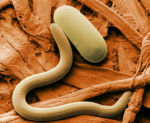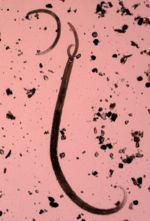| This article is still under construction. |
Introduction
Nematodes are one of the most prolific life-forms on this planet. Most are free-living, with species adapted to every imaginable habitat. Some are parasitic on plants, and others on animals. The animal parasitic nematodes form a large and diverse array of organisms. Occlusion of pancreatic ducts sometimes happens.
Nematode Structure and Function
General Life-Cycle
- The basic life-cycle is very simple:
- egg → L1 → L2 → L3 → L4 → adult
- With a moult in between each larval stage
- But there are many variations on this theme
Nematode Eggs
- These vary greatly in appearance and are very useful for diagnosis as they can often be detected and counted in faecal samples
- NOTE: we use the typical strongyle egg to provide us with a yard-stick for comparing sizes. A "large egg", for example, means larger than a strongyle egg. A typical strongyle egg is approximately 80µm long
<ncl style=compact maxdepth=5 headings=bullet headstart=2 showcats=1 showarts=1>Category:Nematodes</ncl>
From the veterinary view-point, the nematodes are most conveniently grouped into superfamilies because their members often have similar life-cycles and epidemiological features. Superfamily names end in -oidea (the anglicised form is -oid, as in trichostrongyloid).
Nematodes of Different Species
Subcategories
This category has the following 2 subcategories, out of 2 total.
Pages in category "Nematodes"
The following 4 pages are in this category, out of 4 total.

